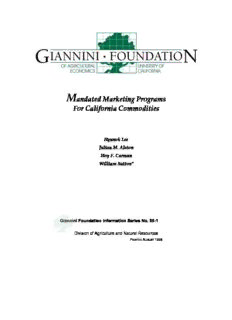
Mandated Marketing Programs for California Commodities PDF
Preview Mandated Marketing Programs for California Commodities
M andated Marketing Programs For California Commodities Hyunok Lee Julian M. Alston Hoy F. Carman William Sutton* Giannini Foundation Information Series No. 96-1 Division of Agriculture and Natural Resources PRINTED AUGUST 1996 AUTHORIZED ACTIVITIES Both federal and state marketing programs may 4.1 Advertising and Promotion c?ntain provisions for one or more of the following Generic advertising and commodity promotion types of activities: 1) generic advertising and sales SIX are designed to increase demand and prices for a rela- promotion; 2) production, processing and market- tively homogene?~s commodity produced by many ing research; 3) quality regulations with inspection; farmers. Advertismg and promotion include con- 4) supply management or volume control; 5) stan- sumer e_ducation and public relations. Media used dardization of containers or packs; and 6) prohibi- for these ac~vities include television, radio, newspa- tion of unfair trade practices. Quality standards and pers, m_ass cm:ulation magazines, and cooking dem-· supply management are regulatory in nature while advertising and research are nonregulatory, market ~trations. From an expenditure standpoint, adver- tismg and promotion is the most important market- support programs. Category (6 ) has been used very ing activity. (In what follows, advertising and other infrequently (Nuckton and French).' These activi- types of promotion are referred to as promotion.) ties are authorized by AMAA for federal marketing orders, and by the California Marketing Act for the . Most commodity groups focus on generic pro- motion. A successful promotion, thus, usually re- state marketing orders. Patterned after state market- ing orders, commission and council laws also include quires that the commodity group accounts for a high provisions authorizing similar activities. p~portion of the supply of the commodity; Califor- rua producers are particularly active in promotion, An important distinction between state and fed- given that California is the major or only U.S. pro- eral marketing programs arises with respect to ac- ducer of such specialty crops as almonds, avocados, tivities authorized. Various types of quantity (vol- pistachios, prunes, walnuts, kiwifruit, olives, table ume) controls are authorized under both federal and grapes and artichokes. Because California produc- state law. However, state programs typically focus ers ~ontrol ~ost of the supply of these crops, they on research and promotion activities. Volume con- are m a position to capture the benefits from adver- trols are not common practice under the state law. tising to increase demand for them (Carman et al.) · Quality controls are also more common in federal pro- In addition to self-financed promotion, supple- grams than in state programs. Of the 48 existing state mental federal and state funding is sometimes avail- marketing programs, 11 are authorized to exercise able to these commodity groups. The U.S. Depart- quality controls and only seven are active. ment of Agriculture grants promotion funds through A major exception to the above discussion is the California state marketing order for milk. California is the only major dairy producing state that operates Figure 1: 1992 Promotion Expenditure Shares by Crop outside the federal milk marketing order system. (Total California Promotion Budget California law and regulations provide for pricep ool- = for State Marketing Programs $86 million) ing, classified pricing by end use, and a quota sys- tem, that together dete1n1ine individual producer revenues. This program is quite distinct from the ?ther state marketing programs and is not analyzed m the present paper. For a description and analysis of this program the reader is referred to Sumner and Wolf (1995) and Ekboir, Sumner, and Wolf (1995). Plstac:ihlo. 2 ·-· S""b.•.W.beni 3% 6 The most common use has been to comply with regulations about price .posting so that growers will know what price they are to be paid for cu11ent deliveries. Since the mid~I 960s, it has only been applied to cling peaches, strawberries for processing, and pistachios, under the California Act. - 1 The Federal orders for almonds, hazelnuts and olives per111it brand advertising credits but these credits are not presently be- ing used (Powers, p.20) 6
Description: